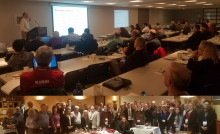NJIT Hosts 2018 HamSCI Workshop
NJIT Hosts 2018 HamSCI Workshop

The 2018 HamSCI Workshop held at the New Jersey Institute of Technology (NJIT) February 23-24, 2018 brought together hams and space scientists from across the United States, Canada, and Great Britain. With over 60 people in attendance, presentations included results from the 2017 Great American Eclipse, ideas for a personal space weather station, and other amateur radio-space science experiments and projects.
Friday focused on techniques and methods for collecting and analyzing large-scale amateur radio data, as well as results of the eclipse experiments. Bill Engelke, AB4EJ, of the University of Alabama presented on the HamSCI Amateur Radio Communications (HARC) database and DX Display System that unifies Reverse Beacon Network (RBN), WSPRNet, and the NASA OMNI space physics databases. Philip Gladstone, N1DQ, the founder and owner of the PSKReporter system, shared insights into the PSKReporter system architecture and the impacts of the new FT8 digital mode. Dr. Ethan Miller, K8GU, of the Johns Hopkins University Applied Physics Laboratory, showed techniques for using RBN observations to estimate ionospheric maximum usable frequency (MUF) and foF2 critical frequencies.
The solar eclipse presentations included results that incorporated many different measurement techniques. The Solar Eclipse QSO party generated a number of studies of amateur HF propagation presented by NJIT, Virginia Tech, the Marshall Space Flight Center, and amateur contributors. These presentations showed that in addition to propagation effects related to the expected decrease in ionospheric densities during the eclipse such as a decrease in 14 MHz signal strengths, a lengthening of 7 MHz ray paths, and an increase in the number of 1.8 and 3.5 MHz contacts, subtler effects were also observed. This includes Doppler shifts at LF and HF relating to the changing propagation path lengths as the eclipse passed overhead. Presentations using professional instrumentation systems such as GPS Total Electron Content (GPS-TEC) Monitoring systems and Incoherent Scatter Radar (ISR) were presented by scientists Dr. Anthea Coster and Dr. Larisa Goncharenko from the MIT Haystack Observatory. They showed evidence of bow waves generation by the eclipse, as well as an upwelling of electrons from the ionosphere into the plasmasphere, which hours after the eclipse returned to the ionosphere to produce higher than normal electron densities.
On Friday night, Dr. Philip Erickson, W1PJE, of the MIT Haystack Observatory gave the keynote address at the workshop banquet. Dr. Erickson reviewed the science and engineering accomplishments of many of the key figures in the CQ Hall of Fame and presented open questions that could be addressed by future ham radio-science collaborations.
In order to help hams and scientists speak the same language, Ethan Miller opened the Saturday program with a tutorial entitled “Space Physics for Radio Amateurs and Ham Radio for Space Physicists.” This talk highlighted the capabilities of ham radio operators and the interesting propagation that they enjoy. Next, Dr. Ben Witvliet, PE5B/M0IJQ, a long-time ham who recently earned his Ph.D. studying Near Vertical Incidence Skywave (NVIS) propagation, summarized his findings in a talk entitled “NVIS Field research in Spain: Science or Adventure?” Following this, Dr. Gareth Perry of the University of Calgary present results from an experiment where he used the CASSIOPE satellite to listen to Field Day 2015 signals and provides an explanation for the fast variability observed in received signal power.
Saturday afternoon presentations presented ideas for developing a personal Space Weather Station. This is a device that a ham could install at their station to make measurements such as ionospheric absorption, geomagnetic field variation, lightning detection, HF propagation and phase measurements. Dr. Nathaniel Frissell, W2NAF, of NJIT presented an overview vision of what this station may look like. This was followed by presentations from the University of Oklahoma, Dartmouth College, NJIT, and the Tucson Amateur Packet Radio Corporation (TAPR) giving more detailed descriptions of how to make these measurements and why they should be made. Steve Bible, N7HPR, TAPR President, discussed the steps for bringing a product from idea to design to shippable product and provided examples from the TAPR history.
Case Western Reserve Amateur Radio Club, W8EDU, brought four students and two advisors to the HamSCI meeting. During the demo room period, they demonstrated the laboratory exercise they developed, “A Hut on Phasors Legs”. This lab is for the examination of analog signals simultaneously in the time, frequency and phasor domains, as well as demodulated audio. Students from the NJIT Amateur Radio Club provided tours of the NJIT ARC Station, K2MFF. Next, University of Iowa graduate student and amateur radio club president Arya Afshari, KE0CHS, presented his work on “Turbulence in the Magnetosheath: Solar Wind - Magnetosphere Interactions,” which showed hams science from the region of space where the solar wind encounters the Earth’s magnetosphere. To close out the meeting, Kai Chen, K2TRW, and Bill Engelke, AB4EJ, presented on the newer Digital Mobile Radio (DMR) and FT8 radio modes.
The 2018 HamSCI meeting was hosted by the New Jersey Institute of Technology Center for Solar-Terrestrial Research. Once collected from the presenters, PDFs of the presentations will be available for download at the 2018 HamSCI Workshop Agenda page.
Related:
